Are your Jenga blocks gathering dust, forgotten in a corner? It’s time to unleash their hidden potential! Brace yourself for a mind-blowing list of cool things you can do with those colorful cubes.
From DIY projects that’ll make you the envy of all your friends to epic games that’ll ignite fierce competition, we’ve got you covered. Get ready to transform those humble game pieces into stunning home decor, educational tools, and party essentials.
Prepare to be amazed as we reveal the endless possibilities. Let’s dive into the world of Jenga block awesomeness!
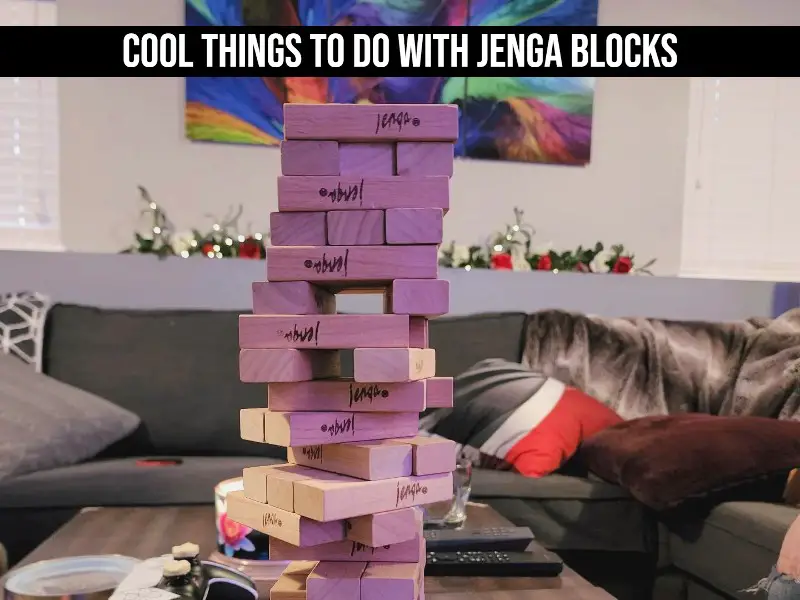
8 Creative & Cool Things To Do With Jenga Blocks
1. Jenga Block Photo Holders
They are a creative and unique way to display your favorite photographs. They are simple to make and add a touch of charm to any space.
Materials Needed:
Jenga blocks – You will need a set of cubes, preferably unused or gently used ones.
Craft knife or saw – To cut them into desired sizes.
Sandpaper – Used to smooth rough edges.
Paint or varnish (optional) – For adding color or protecting the wood.
Preparation:
- Select the puzzle pieces you want to use for the photo holders.
- Measure and mark the desired length for each block. Typically, a length of around 3-4 inches works well.
- Use a craft knife or saw to carefully cut the pieces along the marked lines.
- After cutting, use sandpaper to smooth any rough or uneven edges.
Finishing Touches:
- If desired, you can paint the Jenga block photo holders to match your decor or add a pop of color.
- You can also protect the wood and enhance its natural appearance by applying a coat of clear varnish.
Displaying Photos:
- Once they are ready, insert a small slot or groove into one side of each block to hold the photo.
- Slide the photo carefully into the slot, making sure it is securely held.
- You can display the photo holders individually or arrange them in a row or group, creating a unique and personalized photo display.
2. Jenga Block Mini Planters
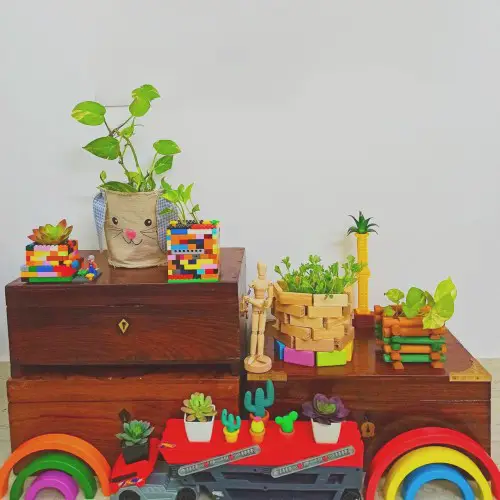
Adding greenery to your living space is easy with the pieces’ mini planters. A brief process of Jenga block mini planters follows:
Materials:
Jenga cubes (wooden or plastic), potting soil, small plants or succulents, and optional waterproof sealant or liner.
Preparation:
Select puzzle pieces that are in good condition and free from any chemical treatments. Ensure that the units are clean and dry.
Size and Configuration:
The blocks are typically rectangular, measuring approximately 1.5 inches wide, 2.5 inches tall, and 7.5 inches long. It is possible to use a single piece as a planter, or you can stack multiple units to create a unique vertical planter.
Drainage:
The units need drainage holes in the bottom to prevent water accumulation. You can use a drill with a small bit to make holes or carefully chisel out a cavity at the bottom.
Waterproofing:
Although they are usually made of wood, which is naturally porous, you can apply a waterproof sealant or use a plastic liner to protect the wood from moisture. This will help extend the lifespan of your Jenga planters.
Plant Selection:
Pick small plants or succulents that will fit into the planter. Opt for plants with shallow root systems and favor well-drained soil. Examples include small cacti, succulents, herbs, or low-growing flowering plants.
Soil and Care:
Fill the planter with potting soil, leaving enough space for the plant’s roots. Take care that the soil is well-drained and provides adequate nutrients for your chosen plants. You should follow the specific care instructions for each plant regarding sunlight exposure, watering frequency, and fertilizing.
Display and Maintenance:
It is possible to use mini planters as a centerpiece on a table or to display them on shelves or windowsills. Regularly monitor the moisture level of the soil and water accordingly to maintain the health of your plants. Moreover, consider rotating the planters to guarantee even light exposure and growth.
3. Jenga Block Wall Art
By arranging and mounting puzzle pieces in unique patterns or designs, you can create a stunning focal point in any room. The following are the steps to create Jenga block wall art:
Block arrangement:
Select cubes of various sizes and colors to add visual interest to the wall art. Experiment with different arrangements such as vertical, horizontal, or diagonal stacking, or even create shapes and patterns.
Mounting:
Use strong adhesive or wall-friendly hooks to secure the Jenga cubes to the wall. Keep them firmly attached to prevent them from falling.
Color coordination:
Consider painting or staining the blocks to match your existing decor or to create a specific color scheme for your wall art. This can add an extra level of customization and visual appeal.
Wall preparation:
Before attaching the Jenga units, make sure the wall surface is clean and smooth. If necessary, you can paint the wall in a complementary color to enhance the overall effect of the wall art.
Personalization:
Put other decorative elements within the block arrangement, such as small plants, LED lights, or even framed photos, for an even more personal touch. You will be able to give your creation more depth and character by doing this.
Maintenance:
Regularly inspect the wall art for any signs of loosening or damage. If any units become loose, reattach them promptly to maintain the integrity of the design.
4. Jenga Block Candle Holders
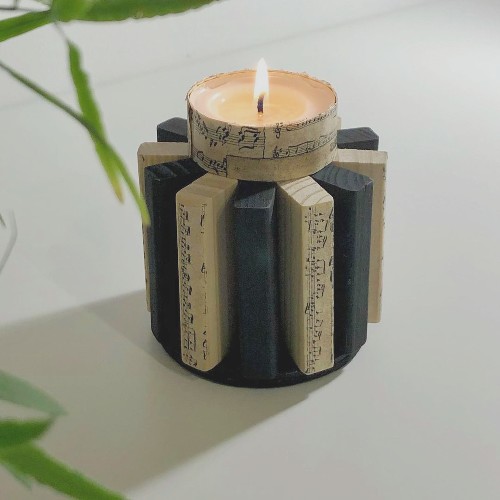
Repurposing Jenga blocks into candle holders offers a delightful and innovative approach to home decor.
Materials Required:
To embark on this project, gather the following materials: Jenga blocks (preferably unused or in good condition), medium to fine grit sandpaper, a ruler or measuring tape, a pencil or marker, a saw, and wood glue.
Preparation Stage:
Begin by meticulously sanding the blocks to eliminate any rough edges or splinters, guaranteeing a sleek surface for the candle holders.
Measurement Phase:
Determine the hole size needed to accommodate your candles by measuring their diameter. On the top face of each cube, distinctly mark the center point.
Cutting Process:
Utilize a saw with precision to skillfully cut holes in every block at the designated center points. For a snug fit, the holes should be slightly smaller than the diameter of the candles.
Finishing Touches:
Smoothen the edges of the cut holes by sanding them. Alternatively, you can sand the entire block to achieve a polished appearance.
Assembly Stage:
Apply wood glue to the bottom of each candle holder and firmly press it onto a flat surface. This step ensures stability when the candle is placed inside. Allow sufficient drying time for the candle holders before use.
Safety Precautions:
It is important to remember to place the candle holders on a heat-resistant surface and never leave burning candles unattended.
5. Jenga Block Stacking Competition
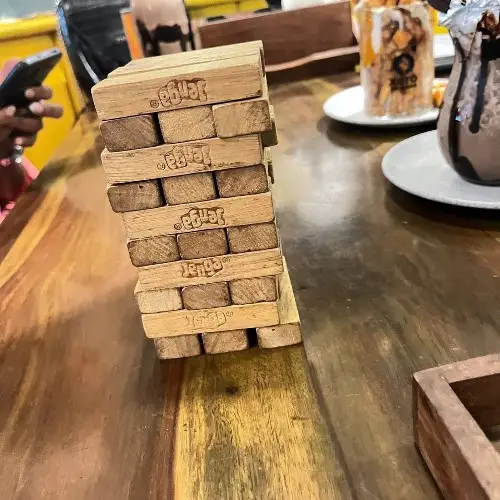
The stacking competition is an engaging and exciting activity that can be included in the list of cool things to do with Jenga sets. Here are the steps for this particular activity:
Objective:
The objective of the competition is to build the tallest tower possible using units without causing it to collapse.
Equipment:
The competition requires a Jenga set, which consists of 54 wooden blocks stacked in a tower formation.
Rules:
- Every participant takes turns removing one unit from the building and placing it on top.
- The blocks must be removed using only one hand.
- It can be tapped or nudged to find loose cubes, but it cannot be intentionally manipulated to make removal easier.
- After a cube is touched, it must be used for the next move. No switching or rearranging cubes.
- The tower must remain stable for at least 10 seconds after a player’s move before the next turn.
- If it collapses during a player’s turn, that player is eliminated from the competition.
Scoring:
At the end of the competition, the winning tower is determined by its height. The tallest standing building without collapsing is winning.
Strategies:
- Players can strategically choose units from the lower levels that are easier to remove without destabilizing the tower.
- Careful observation of the building’s stability and identifying loose or wobbly blocks can help in making strategic moves.
Variations:
It is possible to introduce different variations to the competition to increase its challenge and interest. For instance, some rounds can be performed in speed (where players have a limited amount of time to make their moves) or blindfolded (where players rely solely on their touch and memory to make their moves).
6. Jenga Block Dominoes
It is a fun and engaging activity that transforms traditional Jenga sets into a domino setup.
Setup:
Start by arranging pieces in a line, placing them vertically with small gaps in between to create a domino-like structure.
Stability:
The units are well-suited for domino setups due to their rectangular shape and stable construction. As they balance on top of each other, they can stand upright without falling over.
Chain Reaction:
After assembling the dominos, you can initiate a chain reaction by carefully tipping the first block over. The force of the falling unit will cause the subsequent cubes to fall, creating a visually appealing and satisfying domino effect.
Customization:
Dominoes offer flexibility for customization. You can experiment with different patterns, designs, and layouts using various colored or decorated blocks to add visual interest and creativity to the setup.
Size and Scale:
Depending on the available space and desired complexity, you can adjust the size and scale of the domino setup. It can range from a small setup on a tabletop to a larger setup that extends across a room or even outdoors.
Experimentation:
The dominoes can be combined with other elements like ramps, bridges, or obstacles to create unique challenges and variations. It allows for experimentation and encourages problem-solving and critical-thinking skills.
Cleanup and Reusability:
After the domino effect has been triggered and enjoyed, cleaning up the fallen units is relatively easy. They can be stacked back together and reused for future domino setups or other creative projects.
7. Jenga Block Math Games for Kids

The games give an interactive and engaging way to enhance mathematical skills while having fun. Kids can play math games by following these steps:
Addition and Subtraction:
Write numbers on all pieces and assign a mathematical operation to each color or pattern on the blocks. Every child can remove a cube and solve the corresponding addition or subtraction problem.
Multiplication and Division:
Similar to the addition and subtraction game, puzzle pieces can be labeled with numbers and different mathematical operations. Kids can practice their multiplication and division skills by solving the equations as they remove the pieces.
Fractions and Decimals:
Assign fractions or decimal values to different units. Kids can build towers using blocks with fractions or decimals and then add or multiply the values to reinforce their understanding of these concepts.
Number Patterns:
Write a sequence of numbers on the Jenga cubes, and kids can remove cubes to continue the pattern. This game helps develop critical thinking and pattern recognition skills.
Counting and Number Recognition:
Mark each game piece with a different number. Kids can stack the cubes in order or remove units and count the remaining numbers. This game reinforces counting skills and helps with number recognition.
Place Value:
Write digits on blocks and assign a place value to each unit (ones, tens, hundreds, etc.). Kids can create numbers by stacking the units in the correct order, allowing them to practice understanding and manipulating place value.
Word Problems:
Place word problems on cards and place them on the table. Every unit that kids remove corresponds to a step in solving the word problem. By physically interacting with the blocks, children can visualize the problem and work through the solution.
8. Jenga Block Drink Stirrers
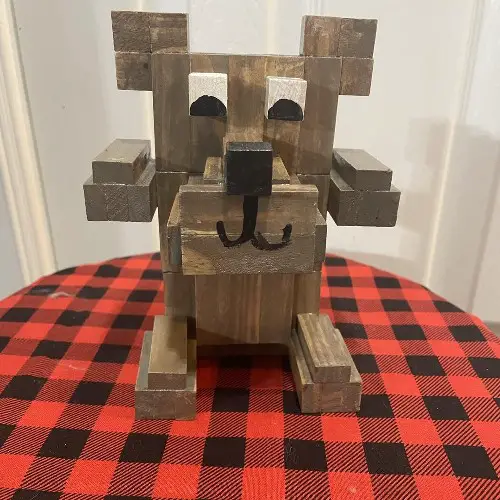
Jenga units can be repurposed as unique and eye-catching drink stirrers.
- Simply take a few pieces and clean them thoroughly.
- Use non-toxic paint or food-safe markers to decorate the units with fun designs or patterns.
- Be sure that the paint or markers are completely dry before adding them to the beverage.
- Gently insert the decorated unit into the drink as a stirrer.
- Its sturdy nature of it allows it to mix drinks effectively without breaking.
- The drink stirrers add a playful and creative touch to cocktails, mocktails, or any beverage.
- Guests will enjoy the novelty and conversation-starting element of these unique stirrers.
- Remember to wash the Jenga cubes thoroughly after each use to maintain hygiene.
- Experiment with different colors, designs, and themes to match the occasion or party decor.
- The stirrers are a suitable way to showcase your DIY skills and impress guests at your next gathering.

